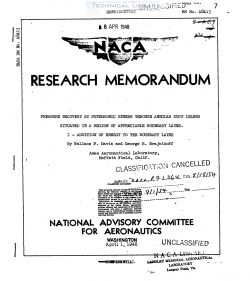naca-rm-a8a13
- Version
- 45 Downloads
- 790.40 KB File Size
- 1 File Count
- April 20, 2017 Create Date
- April 20, 2017 Last Updated
National Advisory Committee for Aeronautics, Research Memorandum - Pressure Recovery at Supersonic Speeds Through Annular Duct Inlets Situated in a Region of Appreciable Boundary Layer - I - Addition of Energy to the Boundary Layer

A model having a nozzle upstream of an annular duct inlet for
the purpose of ejecting high—velocity air into the boundary layer
of the flow along the forebody was tested at Mach numbers between
1.36 and 2.01. lZEhe size and location of the nozzle and the total
pressure of the air in the Jet were varied to determine their
effects upon the pressure" recovery attainable after diffusion
through the duct inlet. ‘Ihe results of the tests showed that the
maximum total-pressure recovery was greater than that of a model
having no air ejected. The causes of the greater recovery were
the delay in the separation of the boundary layer that resulted
from mixing between the boundary layer and the Jet and also the
reduction in the intake Mach number caused by an oblique shock
wave that originated from thenozzle outlet when the free boundary
of the Jet was divergent.
If the high—pressure air ejected through the nozzle were
supplied by the compressor of! a turbo—Jet engine contained in the
model, the improvement in the pressure recovery measured during
the tests would not be entirely useful in increasing the thrust
force of the engine, because some of the available energy would
have to be used to recirculate the air. Calculations showed that
recirculating air through the intake system of an assumed engine
caused an 8—percent improvement in the pressure recovery effective
in producing thrust. This improvement would probably be larger if
the tests were performed under full—scale flight conditions.
These principles were used in the design of the models described
in reference 2. The rate of compression of the supersonic stream
was decreased by creating an oblique shock wave upstream of the duct
inlet to reduce the Mach number at which the maJor portion of the
compression occurred. The amount of boundary layer relative to the
total mass of air flowing through the intake was diminished by
using an inlet of the same area as the annular entrances but which
enclosed only a portion of the forebody. The maximum recovery of
total pressure that was attained in the tests of these models, was
about four—fifths that of a normal-shock wave.
| File | Action |
|---|---|
| naca-rm-a8a13 Pressure Recovery at Supersonic Speeds Through Annular Duct Inlets Situated in a Region of.pdf | Download |

Comment On This Post